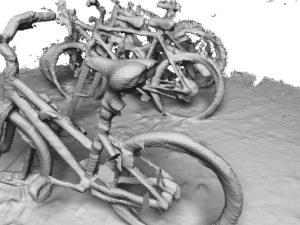Nowadays, it’s not such a rarity to see the use of 3D scanning to recreate historic artifacts or museum-worthy sculptures. The British Library is utilizing a 3D scanner to capture some of their massive collection of texts and artifacts, and others are using the technology to make valuable museum pieces more accessible. But, what about the objects we see in our daily lives? From the chairs we sit in to the cars we drive, these items can oftentimes go unappreciated (as well as unscanned and unprinted).
 The 3D scanning database Redwood Data has recently unveiled more than 10,000 unique 3D scans of objects from our everyday reality, ranging anywhere from books, kitchen equipment, and trash bins to bicycles, grand pianos, and shoes. To accomplish this, Redwood Data recruited 70 individuals to operate consumer-grade 3D scanning systems, compensating them in exchange for scanning their surrounding environment. The 70 scanner operators choose to scan what they wanted, the result of which was a vast database composed all sorts of real world objects. After ensuring the the data acquisition did not violate and privacy laws, the 3D scanned objects were released within the public domain.
The 3D scanning database Redwood Data has recently unveiled more than 10,000 unique 3D scans of objects from our everyday reality, ranging anywhere from books, kitchen equipment, and trash bins to bicycles, grand pianos, and shoes. To accomplish this, Redwood Data recruited 70 individuals to operate consumer-grade 3D scanning systems, compensating them in exchange for scanning their surrounding environment. The 70 scanner operators choose to scan what they wanted, the result of which was a vast database composed all sorts of real world objects. After ensuring the the data acquisition did not violate and privacy laws, the 3D scanned objects were released within the public domain.
 The operators utilized PrimeSense Carmine cameras, a 3D webcam with a resolution is 640×480 and a 30Hz frame rate. PrimeSense is an Israeli 3D sensing company, which was acquired by Apple back in 2013. Although the PrimeSense Carmine 3D cameras are considered consumer-level, they certainly seem capable of capturing the details of this eclectic group of objects.
The operators utilized PrimeSense Carmine cameras, a 3D webcam with a resolution is 640×480 and a 30Hz frame rate. PrimeSense is an Israeli 3D sensing company, which was acquired by Apple back in 2013. Although the PrimeSense Carmine 3D cameras are considered consumer-level, they certainly seem capable of capturing the details of this eclectic group of objects.
According to Redwood Data, the most popular objects that the camera operators scanned were cars, followed by chairs, sculptures, books, tables, and so on and so forth. The entire chart of 3D scanned objects can be seen below.
The database includes both RGB-D scans (the scanning sequence) and the reconstructed models, which can be download for free. The 3D models are organized into the PLY files, a format created to store the many facets of 3D scan data. The PLY format is similar to a STL file, seeing that is a wireframe mesh representation of a 3D part. You can access, browse, and download the thousands of 3D scanned objects on Redwood Data’s website, and maybe even get inspired to start capturing your own environment with a 3D scanner. Discuss further in the Redwood Data 3D Release forum over at 3DPB.com.
[Source: Redwood Data]Subscribe to Our Email Newsletter
Stay up-to-date on all the latest news from the 3D printing industry and receive information and offers from third party vendors.
Print Services
Upload your 3D Models and get them printed quickly and efficiently.
You May Also Like
Reinventing Reindustrialization: Why NAVWAR Project Manager Spencer Koroly Invented a Made-in-America 3D Printer
It has become virtually impossible to regularly follow additive manufacturing (AM) industry news and not stumble across the term “defense industrial base” (DIB), a concept encompassing all the many diverse...
Inside The Barnes Global Advisors’ Vision for a Stronger AM Ecosystem
As additive manufacturing (AM) continues to revolutionize the industrial landscape, Pittsburgh-based consultancy The Barnes Global Advisors (TBGA) is helping shape what that future looks like. As the largest independent AM...
Ruggedized: How USMC Innovation Officer Matt Pine Navigates 3D Printing in the Military
Disclaimer: Matt Pine’s views are not the views of the Department of Defense nor the U.S. Marine Corps Throughout this decade thus far, the military’s adoption of additive manufacturing (AM)...
U.S. Congress Calls Out 3D Printing in Proposal for Commercial Reserve Manufacturing Network
Last week, the U.S. House of Representatives’ Appropriations Committee moved the FY 2026 defense bill forward to the House floor. Included in the legislation is a $131 million proposal for...


































